- --> Login or Sign Up
- Login or Sign Up -->
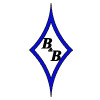
- B&B Annual Messabout
- Capsize Camp
- All Kayaks and Canoes
- Diva 15'8" Kayak
- Grand Diva 17'6" Kayak
- Moccasin 12' Canoe
- Flyfisher 13' Canoe
- Moccasin 14' Canoe
- Moccasin Double 15'6" Canoe
- Birder Decked Canoe 13' and 15'8
- Expedition Sailing Canoe
- All Dinghies and Tenders
- Catspaw Pram
- Spindrift Dinghy
- All Sailboats
- Core Sound 15
- Core Sound 17
- Core Sound 17 Mark 3
- Core Sound 20
- Core Sound 20 Mark 3
- Bay River Skiff 17

Belhaven 19
- Mini Trimaran
- Class Globe 5.80 Kit
- Princess Sharpie 22'
- Princess Sharpie 26'
- All Powerboats
- All Jessy Skiffs 12-17'
- Jessy 12'
- Jessy 15'
- Jessy 17'
- All Outer Banks Cruisers
- Outer Banks 20
- Outer Banks 24
- Outer Banks 26
- All Ocracoke Center Consoles
- Ocracoke 20
- Ocracoke 20-B
- Ocracoke 24
- Ocracoke 256
- Cape Lookout 28
- Wing Foil Kits
- All Other Kits and Plans
- "Tractor" Canoe Seat
- Mast Head Floats
- Windvane Self Steering
- All Building Supplies and Tools
- Marine Plywood
- All B&B Epoxy
- Temperature Control for Epoxy
- Epoxy Additives
- All Hardware and Rigging
- All Rigging
- Eyestraps and Fairleads
- Shackles, Hooks and Pins
- All Rudder Hardware
- Pintles and Gudgeons
- Tillers and Accessories
- Hardware kits
- All Masts, Track and More
- 6061-T6 Aluminum Tubing
- Sailtrack and Accessories
- Starboard Mast Plugs
- Wind indicators
- All Electrical
- Battery Monitors
- Solar Power System
- Boarding Ladders
- Beach Rollers
- All Apparel
- B&B Approved Products and Tools
Shop by Brand
B&b yacht designs.
- Amarine Made
- Armstrong Nautical
- View all Brands
Shop by Category
- Rudder Hardware
Build Logs Construction Album
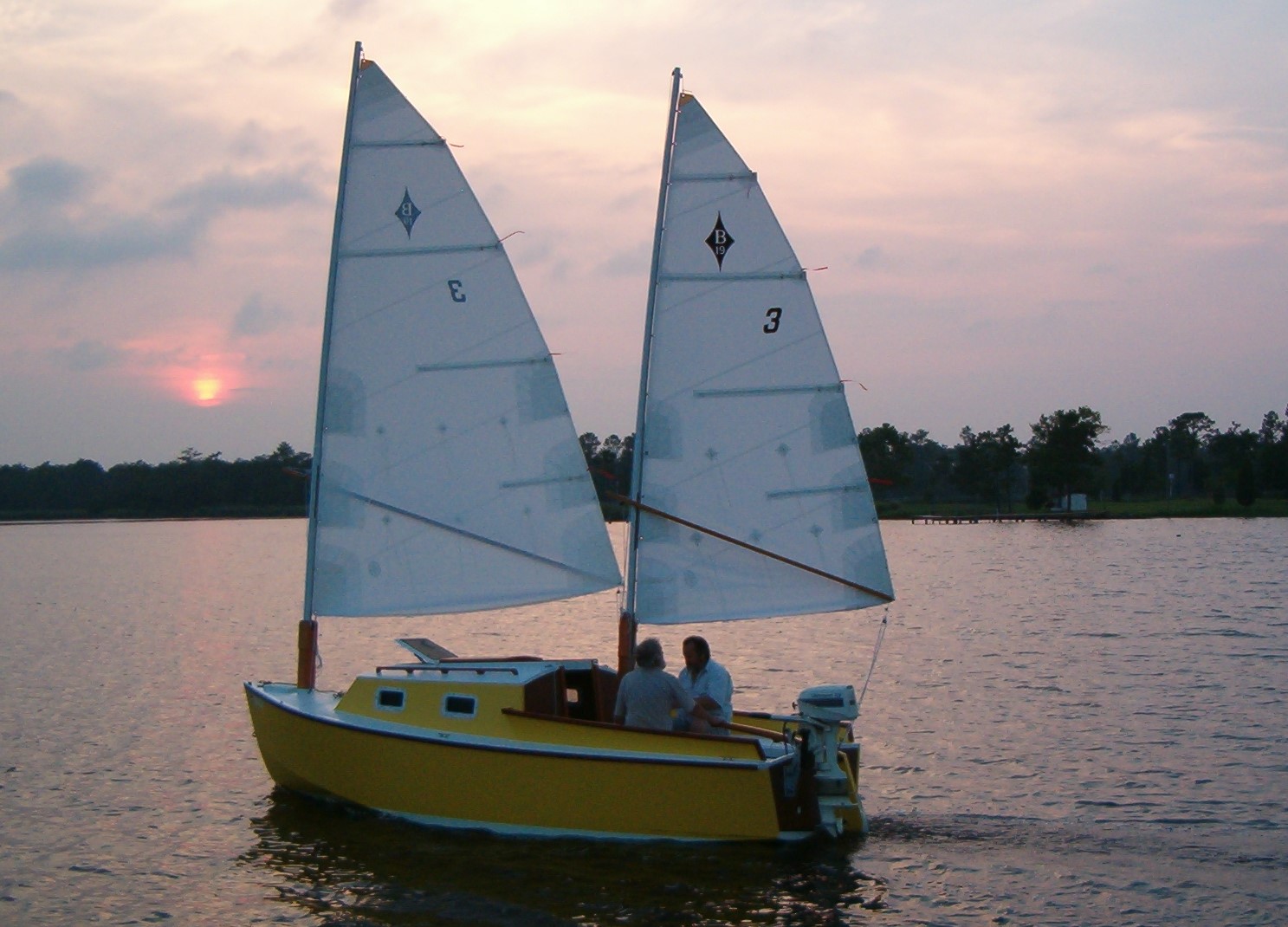
The Belhaven 19 is a development of the Core Sound series which predates the Mark 3 series. It was inspired by the number of queries and requests we got for “a cuddy or cabin” for the Core Sound designs. Requests from around the world, were based on the needs to shelter from both the hot sun of the tropics and the cold winds and spray of the northern climes. Performance is based on the well-known sailing qualities of the Core Sound.
The hull shape and general appearance are closely related to the flavor of the Core Sounds models but with a more spacious interior even than the Core Sound 20 Mark 3.
Safety was a primary concern when the design was conceived. The boat carries floatation in the forefoot and under the cockpit, so she will float when filled with water. The standard configuration gives positive righting to 80 degrees with two crew on board. As with some of our other designs, we are offering the plan with a variable ballast option. You can choose the ballast/draft/ weight ratio which is best for your sailing style and location.
The standard draft is shallow enough to allow the full backwater gunkholing experience. With the board down, her draft and ballast allows you to take on the more open waters with confidence. She is named, Belhaven, after the historic town , located on the Pungo River – a well known place for the wind and waves to kick up and kick in.
The gentle keel shape, with shallow draft and light weight, will make the boat easy to tow without having to purchase a large SUV. Launching and retrieving can be accomplished from a standard type of trailer. The centerboard is offset to port. This allows a completely open interior. Below, hull #23 showing the v-berth forward
A further innovation on this design, a new idea, and one we don’t think you will find anywhere else is the keel/centerboard/fin configuration. When in the full “up” position, the centerboard sits in-line with the keel draft rather than being fully retracted into the hull. To starboard of the centerboard is a small bilge keel fin which is also the same draft as the keel. This combination “tri-pod” (three- footed) configuration offers two essential advantages. First, not only can you launch in shallow water, but you can sail to windward in shallow water – without having to lower the board. This is something you simply cannot do in a keelless flat bottom boat. You can launch a flattie in the shallows, but then you are “out of control” until you can get out far enough to get some of that board down. You are dependent on a motor or some other form of propulsion. With this configuration you can sail right off and on to the launching ramp, beach or dock. You can come and go without help regardless of the wind condition.
Secondly, the tri-pod will make a nice level stand for your boat be it on the beach, in your yard, or on the trailer
The interior is cozy and decidedly comfy in view of the size of the boat. It is enough interior to get out of the weather and camp in reasonable comfort for a family of 3-4 (if two are young children). There are three full length settee/berths a small efficient galley a space for a small porta-potti. The forward V- berth is 6’4″ 1.93m and may be used as two singles or a double with filler cushion , the pilot berth is 6′ 6″ 1.98m. There is about 4′ 7″ 1.39m headroom in the salon cabin – adequate for sensible sitting headroom for normal height people. The galley is located under the offset companionway hatch, so you can stand up while cooking. Although this is absolutely not offered as a round-the-world, live-aboard interior, you will find a most gracious and inviting space for a boat well under 20′ with performance, shallow draft capabilities.
The cockpit offers a comfortable sailing and lounging environment. The seats are 6″ 9″ 2.06m long to allow for sleeping out under the stars. The mizzen is set high enough to set up a bimini underneath – to protect you from the sun in hot climates or for those sensitive to the solar rays. The cockpit is self-draining. There is no cockpit motor well. Because of it’s size, we don’t want to rob cockpit space. For those who need an outboard (up to 6 HP), it may be transom hung. There are two generous cockpit lockers for stowage. While underway, a modern compact outboard will easily stow in one of these, or the outboard can ride on it’s bracket on the transom.
The boat sports the cat ketch rig like the Core Sound. As we have stated the virtues of this rig elsewhere on this site, suffice to say to our new visitors that this is the relaxed way to sail. No hard work on tacking, no wild jibes, complete downwind control and yet great performance. The two shorter masts make trailering and set up easier. The boat was conceived from the beginning as being available with a sloop rig…for those who feel that they need it. Why a cat ketch?
The construction is stitch and glue marine plywood utilizing our own B&B “butterfly” method, which greatly simplifies hull assembly. There is no lofting, no jig building, no pattern working required. Measurements (just straight line measurements) are simply transferred directly onto the plywood and cut out. Even an inexperienced builder can make a nice job of this boat.
LOA………..19′ 0″ [5.79m]
LWL………..17′ 6″ [5.33m]
BEAM…….. 7′ 0″ [2.13m]
DRAFT.. 9″ – 3′ 9″ [.23m -1.15m]
SAIL AREA 164 sq. ft. 15.24sq. m working sail including roach
BOAT WEIGHT…1100# +/- [500 kg] (ballast variable 300# 136kg as drawn)
DISPLACEMENT 1500 lbs @ DWL
Disp./L 135 — SA/Disp 20 – Cp .55 – LCB .54 of WL aft – PPI 394

Belhaven 19 Plans

- Remember me Not recommended on shared computers
Forgot your password?
Or sign in with one of these services
- B & B Yachts Forum
Belhaven 19 Rigging
By Sauduster March 17, 2021 in B & B Yachts Forum
- Reply to this topic
- Start new topic
Recommended Posts
Im fairly new to sailing and just bought a recently completed Belhaven 19 from the original builder. He did install some rigging hardware but I believe things could be changed possibly the better. Alan from B&B sent me some coresound rigging drawings but I would love to see any pictures anyone might have for the main sail on their Belhaven, especially for main sheet control and reefing from the cockpit. I plan to do the T X 200 this year and wish to get the rigging set as needed.
Dallas, TX
Link to comment
Share on other sites, randy jones.
Congratulations and welcome to the forum. There haven't been a lot of B19's built but you'll find they have a dedicated following. I've owned B19 hull #3 Clementine for about 10 years and would be happy to help you out. I've attached an old photo of the partially rigged mainsail that shows my 4:1 snotter arrangement. I did this to reduce the required pulling force to accommodate hand problems - you may not need it but it sure is nice.
Downhall and reefing lines travel over the cabin top in blocks similar to the snotter sheet and terminate in clam cleats (with clam keepers) at the aft edge of the cabin top.
Mainsheet fairlead and cam cleat are mounted on the forward side of the mizzen tabernacle per plans. I thought that arrangement looked awkward at first but it works great.
I'll look for other photos or perhaps take new ones.
Great boat for the TX 200.

Posting the bottom half of the photo showing the snotter line routing up the cabin top. Other one is the two-piece boom that breaks down to fit into the cabin for storage.

I was hoping some Core Sound mk3 owners would chime in. There have been some clever rigs devised for their boats. I’m sure most of them would work on a Bellhaven. I’m thinking especially of the reefing setups. Have you looked into the archives of some of those builds? I have a Bay River skiff without reefing. I would like to suggest that you add a tiller brake. I installed one on mine. Found the design in a book written by Roger Barnes.

- 1 month later...
I finally got out for a sail a got a few photos. There is an important detail regarding where the mizzen sheet lands on the tiller. It needs to be located vertically inline with the rudder pins (not on the rudder head) or it will pull the rudder in the direction of the mizzen sail. Moving the mizzen sheet block does result in uplift of the rudder which I solved with a tiller downhaul. This arrangement has worked well on my boar for several years and I'd recommend it for your Texas 200 trip.
Thrillsbe is spot on regarding the reefing - same as the CS series except you need standing blocks to get over the cabin top.

Join the conversation
You can post now and register later. If you have an account, sign in now to post with your account.

× Pasted as rich text. Paste as plain text instead
Only 75 emoji are allowed.
× Your link has been automatically embedded. Display as a link instead
× Your previous content has been restored. Clear editor
× You cannot paste images directly. Upload or insert images from URL.
- Submit Reply
- Existing user? Sign In
- Become a Supporting Member
- Leaderboard
- Online Users
- Email Delivery Problems
- All Activity
- Create New...
Important Information
By using this site, you agree to our Terms of Use .
My Texas 200
A five-day sail-and-oar raid along the Texas coast
From Issue May 2023
R EDWING, my home-built Belhaven 19, was one of 80 or so boats that entered the 2022 Texas 200, a raid covering a 200-mile-long stretch of the Texas coast. The course meanders north roughly following the Intracoastal Waterway (ICW) over a five-day period beginning June 14th. Much of the mainland and many of the barrier islands along the route are uninhabited and covered with scrub.
I thought my boat and I were ready for the challenge. I had finished building REDWING the previous fall and sailed her on my local Kansas lake all spring, leaving her docked in the water for several weeks to make sure she was watertight. The boat sailed great as I prepped for the challenge.
As I was making final preparations while docked at my lodging in Port Mansfield, I noticed the rope used to lift my offset centerboard was loose. I unscrewed the trunk top and quickly realized the rope-to-board attachment had broken off during transit. Only then did it dawn on me that I had not lowered the board onto the support I had built on its trailer to keep pressure off the board’s lift system so this would not happen.
My truck and trailer were parked 200 miles north of me, up the coast at Magnolia Beach, waiting for me to finish; I couldn’t just pull out of the event here and go home. The few sailors I had met had already taken off, so I couldn’t enlist them to help. They were sailing across Lower Laguna Madre along the dredged Mansfield Channel, across Padre Island (a 113-mile-long barrier island), along the 3-mile-long East Cut to Camp One, nestled in the protection of the Mansfield Jetties guarding its opening onto the Gulf of Mexico. I didn’t know anyone near the launch area, so I had only myself to figure this out. I decided to jury-rig the centerboard lift rope so I could make it to Camp One, where I could get assistance from some of the knowledgeable builders sailing the raid and, with their help, fix my problem.
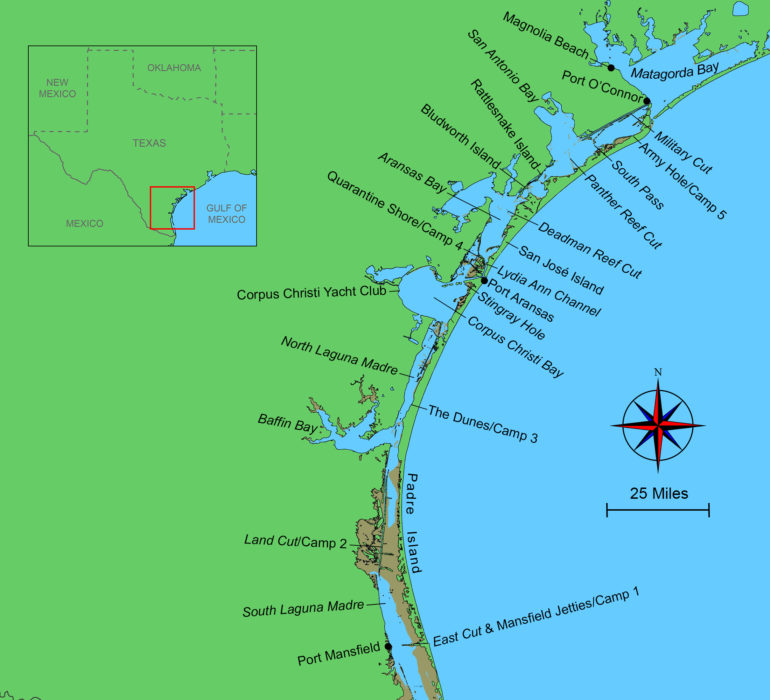
I tied a line to one side cleat and ran it under the boat to the opposite side, believing I could apply enough force to raise the centerboard by pulling on the line, which I could then cleat off. I was able to raise the board some, but not all the way up. With it down, REDWING draws close to 4′; with the board fully raised she can sail in 8″ of water. I guessed the keel was up about a third to halfway and I was drawing 2′ or so. The board weighs 50 lbs with most of its weight, molded lead ’glassed onto the wood, at its tip.
My boat looked goofy with a line cinched tight around her waist, and sailed poorly with her board only partially lowered with a 1⁄4″ rope spoiling the smooth flow of water around the hull. As I headed out of the marina, REDWING was double-reefed and had trouble beating to windward on a heading due east to Camp One, which was 9 miles away at the far end of a manmade cut that connects the protected waters of Laguna Madre to the Gulf of Mexico. The wind was cranked up with gusts up to 30 knots. At one point, I drifted to leeward out of the channel, hit bottom hard, and came to a stop. I started my outboard and was able to back out of that predicament.
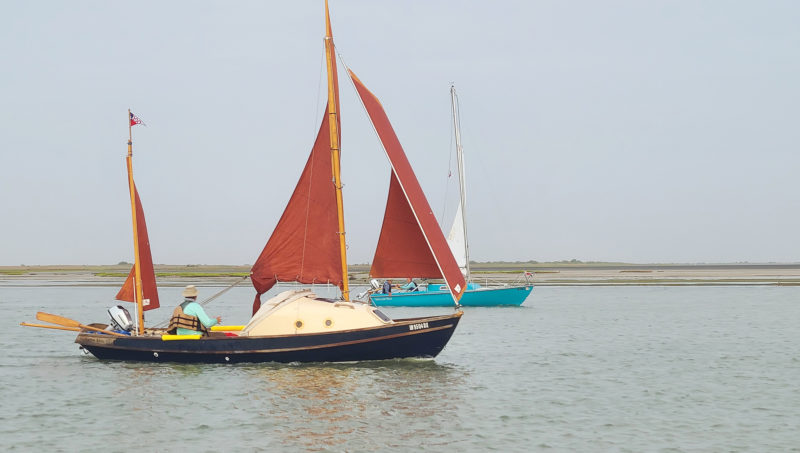
KATHERINE ANNE, the dark blue Drascombe Coaster owned and singlehanded by Tommy Tucker, sailed the Land Cut alongside WATER ON THE MOON, a MacGregor Venture 21 custom-modified by John and Jennifer Harnett.
I knew there was a group bypassing Camp One and heading to Camp Two to spend the second day fishing. So, instead of fighting the wind with a broken boat that wouldn’t point worth a darn, I bore away and headed north for Camp Two on the Land Cut, a 20-mile channel dug across Saltillo Flats, an expanse of tidal shoals, mud, sand, and islets that separate North and South Laguna Madre. By skipping Camp One, I’d have a full day to work on the centerboard before the bulk of the fleet caught up. I removed the sad-looking line from the board, let the board drop, and took off downwind on the best sail of my life. REDWING was flying. The navigation app on my phone consistently read 6, 7, and 8 knots as I tore along South Laguna Madre headed to the cut. With the wind at my back, I was having a blast. It was easy keeping the green markers to starboard and red to port. To avoid commercial traffic, I stayed as far to the side of the channel as possible, as we’d been instructed in our pre-departure briefing.
After an hour of high-speed sailing, I noticed 1″ of water sloshing in my cabin, not enough to worry about sinking, but enough to be highly irritating. I threw some sponges down into the cabin and periodically went down to wring them into a bucket.
I entered the Land Cut in the early afternoon. The ICW narrowed to about 100 yards, but the sailing stayed the same. There are no hills or trees to break the wind, so REDWING continued clipping along.
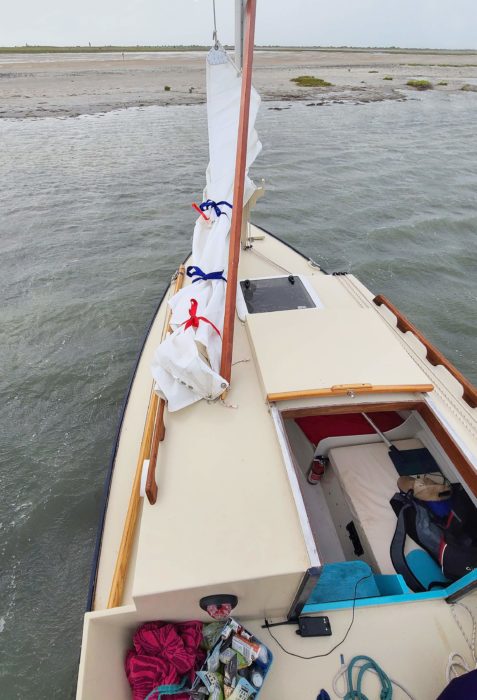
The afternoon of Day One I was stuck on a mud bank in the Land Cut, a couple of miles south of Camp Two. The centerboard was not operable at this point, and I was about to enter the cabin to remove the top of the centerboard trunk and assess the problem. The trunk is offset to the port side and not visible.
B y midafternoon, as I was getting close to Camp Two, I wanted to stop along the channel and deal with the water intrusion. As I was lowering the outboard and firing it up so I could drop the sails, I got lazy and let a wind gust blow REDWING into a mud bank. I was stuck in 4″ of water with the wind and waves pushing me onto a lee shore. I quickly dropped and bundled the sails to relieve some of the pressure pushing me into the mud. I tried backing out with the outboard in reverse, but that didn’t work. I pulled my secondary anchor—a light Danforth knock-off I had been given—out of the stern locker and tossed it as far into the wind as I could, maybe 8′ out. I tried kedging off the mudflat; that didn’t work. It all seemed futile as long as the wind was howling from the southeast. I was stuck.
After sponging several buckets of water out of the cabin, I started snooping around for the leak. I found only one place where there was a shiny telltale sign of seepage. It was from the gudgeon bolts in the transom. Evidently, I hadn’t sealed those holes well. It took me eight years to build my boat, and in my rush to finish it I must have missed caulking the bolt holes. To my credit, I had left REDWING in the water for three weeks prior to leaving home for this trip, and had sailed her hard with no problems, but my best guess is that being loaded with expedition supplies was causing the boat to ride lower in the water, submerging the lower gudgeon bolt holes. Unfortunately, the bolts were not easy to access; I couldn’t pull them under these conditions. I would live with the leak for now, glad I had good sponges.
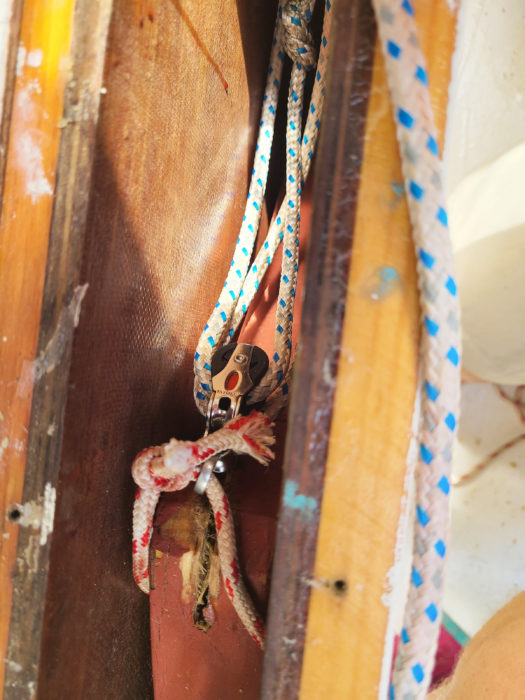
With the cap of the centerboard trunk removed, you can see the damaged wood on the board where the lifting hardware worked its way out during the long drive to the launch site. The red cord is the loop I made that allowed me to reattach the lifting tackle. This worked well for the rest of the Texas 200.
Next, I unscrewed the centerboard trunk cover and found the board had been pushed almost fully up by the mud bank, giving me easy access to the broken attachment link. I had a new one in my repair stash and had it installed in no time. The board now worked as it was supposed to.
I fully expected to spend the night stuck on the mud bank. There were no fishing boats around that I could ask for a pull. There was still daylight, so I decided to raise the centerboard all the way up, kedge with an anchor off the stern, and simultaneously run the outboard in reverse. REDWING slid right off the mud bank, into the ICW. Another answer to prayer. I motored a mile or so to where I thought Camp Two would be, put two anchors out, and called it good. There was a dried mudflat next to the shore where I thought I could stretch my legs. All my studying for the Texas 200 indicated that there was no way to avoid mud along the Land Cut. The shore here was not only muddy, but the mud had the smell of decaying vegetation. This is the type of mud that when you step into it you sink 6″ or more. The wind was still howling out of the southeast, it was still hot, and I was tired.
A row of red lights from the towering three-bladed wind turbines shone out a few miles to the north. Around 10 p.m. a barge came by steaming all blue lights, playing rock-’n’-roll music.
I couldn’t figure out how to get comfortable enough to sleep in the cabin. I was hot and sweaty lying on the bunk trying not to move and create even more heat. Sometime after midnight I fell asleep. Around 3 a.m. I pulled a sheet over me to warm up. I didn’t need the blankets I’d brought.
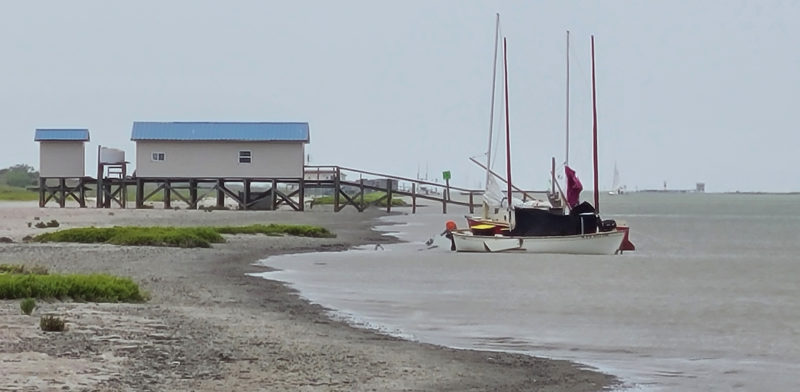
LA BELLE, a white 21′ Sea Pearl owned by Doug Geis, anchored alongside my red Belhaven 19, REDWING, on Day Two. Doug managed to get his tarp set despite the strong winds. The inescapable mud made this, Camp Two, everyone’s least favorite campsite.
E early the next morning, Doug Geis motored up in his Sea Pearl, LA BELLE, and pulled ashore alongside REDWING. He shared that he, too, had gotten stuck on a mud bank yesterday for a few hours until a friendly fisherman with a powerboat pulled him off. That made me feel better.
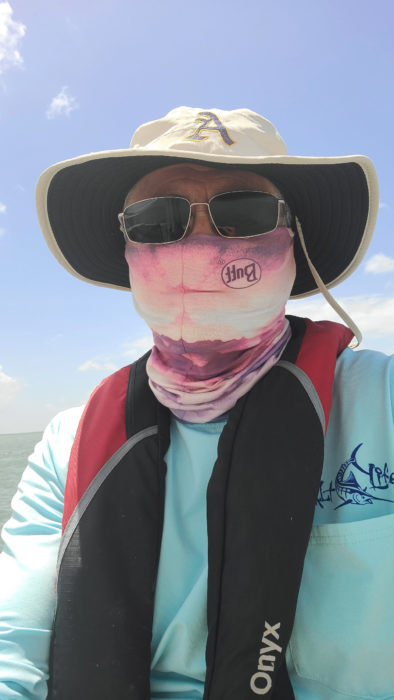
REDWING does not yet have a bimini, so I had to do my best to moderate my sun exposure. I noticed PENNY MAE, the other Belhaven 19 in the fleet, had a bimini, which seemed to be much more comfortable than being swathed like The Invisible Man.
The wind was still blowing like stink and whitecaps were marching north along the cut. Doug wanted to relax and get out of the sun. There is enough room between his two masts for him to spread a tarp for shade, but as he wrestled it against the wind, trying to tie it over LA BELLE’s forward boom, it tried to fly away several times. After a while he got the tarp set, but it had too few grommets to tie it down securely enough to keep it from flapping. I was sure that the noise of its constant snapping would make it impossible for anyone to find rest beneath it, but I didn’t see Doug for a few hours and could only assume he had somehow fallen asleep.
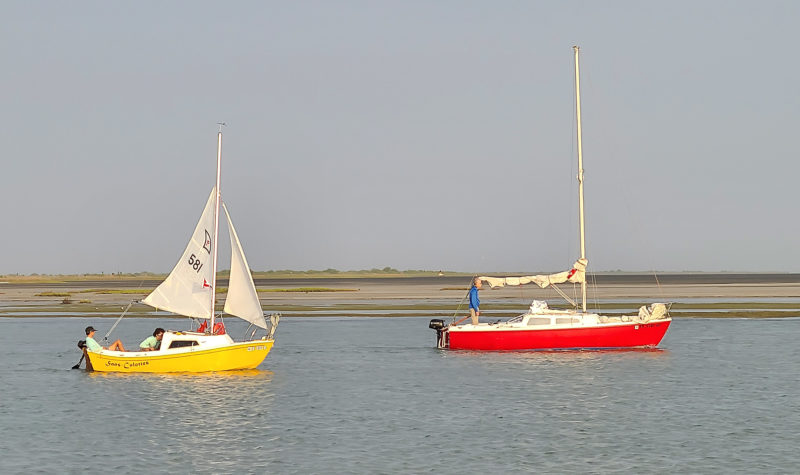
On the morning of Day Three the fleet sailed down the Land Cut toward Baffin Bay. SANS-CULOTTES, the yellow West Wight Potter, was sailed by Conor McAlister and Sam Medina, two Texas teens in the Sea Scout program. It was clear that they were enjoying challenging themselves with no adults to boss them around.
I didn’t have much experience in heavy-weather sailing, but REDWING was designed to sail safely in strong winds. Both sails have two reefs, and the masts are unstayed and bend to spill the wind. I built the hull and I know it is strong. But the Texas 200 is not a race. I could set sail when I felt comfortable to do so; if I sailed conservatively and took care of REDWING, she would take care of me.
Around noon the fast boats—Hobie Cats and trimarans—passed by and continued down the 24-mile-long Land Cut. It seemed that they would not be camping along the Land Cut but were going to land farther north where the beaches are sandy.
I saw fish jumping not too far offshore, so I grabbed my fishing rod and hiked along the shore for a mile trying catch something. No luck. Later, Doug told me the fish I had seen jumping were mullet, and they jump just for the fun and not because they are feeding.
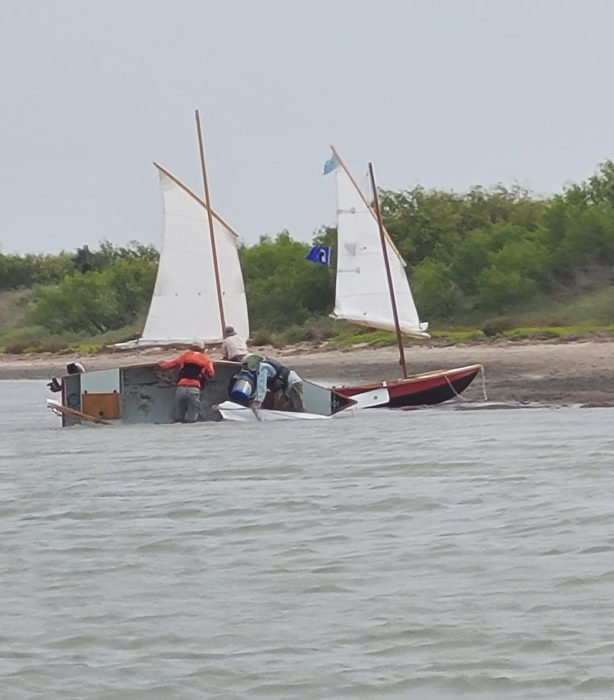
On Day Three, as the fleet was sailing the north end of the Land Cut, fellow sailors assisted a member of the fleet who had accidentally capsized.
At about 3 p.m., my friend, Fred Jelich, on his home-built Buccaneer 24 trimaran, MALABARKA, pulled alongside. He had stopped earlier that afternoon along the Land Cut to chat with some other crews whose boats were anchored. While there, his boat had broken free of its anchor and started on its own journey down the ICW. Fred made a last-ditch jump for the high-sided transom while his feet were still sunk in the thick, oozing mud, and lost his sandals in the process. Somehow, he managed to get a hold on the stern of the main hull and hung on as he was dragged through the water of the ICW. Fortunately, another boat came to his rescue and helped him climb aboard and regain control of his wayward boat.
It was approaching 5 p.m. when what looked like a 20′ sloop tried to anchor 100 yards north of where Doug, Fred, and I had pulled ashore. The soloing sailor seemed to be having trouble getting his boat close enough to shore to throw an anchor out and get it set. He was struggling and it wasn’t going well. He slipped into the water with his anchor and rode and began swimming to shore. I quickly put on my muddy shoes, hopped off my boat, ran down the beach, waded in up to my shoulders, and grabbed his anchor. Together we pulled his boat in.
The wind never let up that day, and I would spend a second night here. There was no phone reception, no firewood, and no shelter from the howling wind. We pulled our chairs out for a bit of socializing, but it didn’t last long. We were all tired and looking forward to the next day’s Camp Three, which had a nice sandy beach free of mud.
I n the morning, another group sailed by. My plan was to motor out into the ICW, then raise the sails as I drifted down the ICW with the wind at my back. It seemed it would be a sailorly thing to do, but I quickly discovered that trying to raise the sails with a strong tailwind while trying to manage the outboard motor and tiller would make me look less like a sailor and more like a fool. I got the sails raised and the boat under control just seconds before REDWING drifted onto a mud bank on the shore across from where I had started.
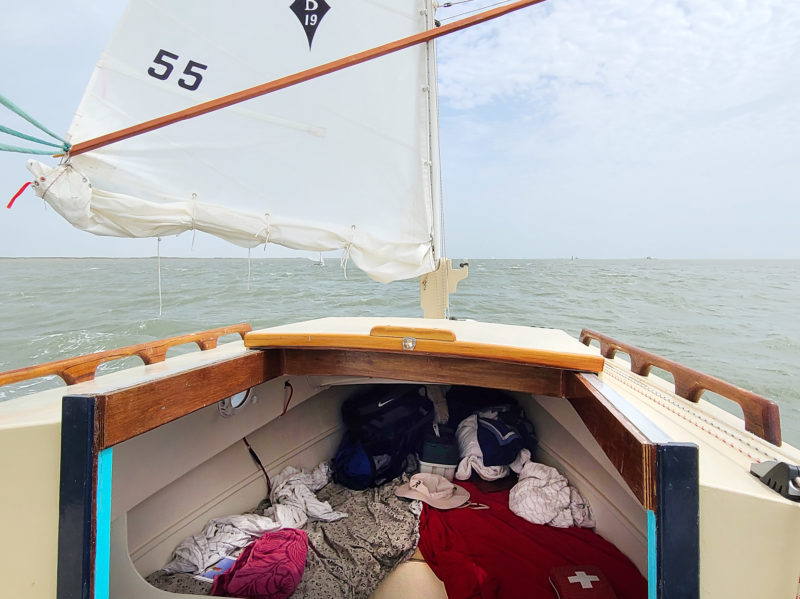
On my way to Camp Three at The Dunes, I crossed Baffin Bay with two reefs in the mainsail and two in the mizzen. The boat off my port bow is also fully reefed. The wind-driven waves were beginning to whitecap, and I enjoyed running downwind with the rollers pushing REDWING along.
The wind was still strong, so I had two reefs in, and even so, REDWING made good speed. I sailed with the fleet north along the Land Cut and crossed the 4-mile-wide entrance to Baffin Bay.
Some 10 miles after leaving Baffin Bay, I turned to the northeast, got off the ICW, and headed for Camp Three at The Dunes. About 2 miles later my centerboard repair failed, and the board deployed itself. I could see the white sand of The Dunes, but I knew I couldn’t make it to the one camp I was most looking forward to. Now that REDWING was drawing close to 4′ I had to re-route. Luckily, my nephew, Brent, a Navy pilot stationed in Corpus Christi, has a home with dock access. I called my wife, who contacted my Corpus Christi family, and a friend from Wichita sent me a Google Map directing me to Brent’s dock. As I was motoring to the dock, I went by the Corpus Christi Yacht Club and recognized several Texas 200 boats tied up alongside for the evening.
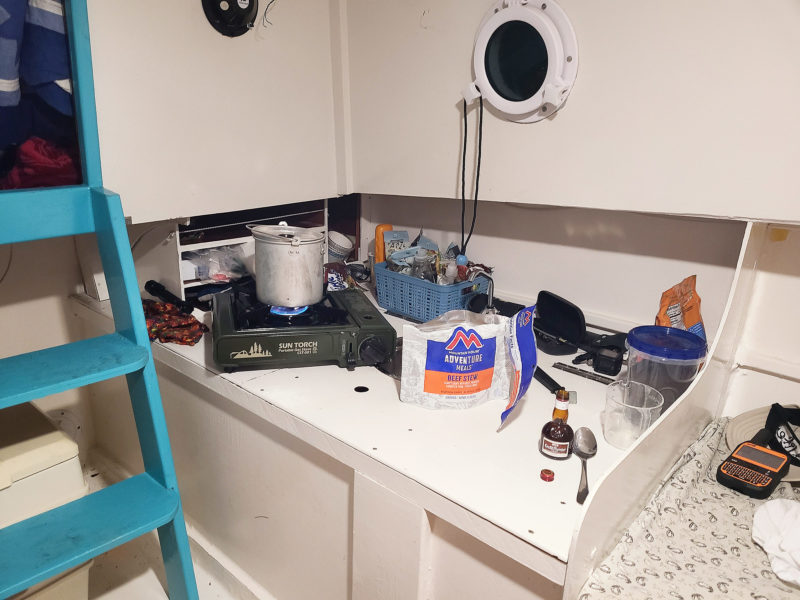
This is a picture of the inside of REDWING as a freeze-dried dinner is being made. Everything stows away neatly for traveling. The centerboard trunk is incorporated as the front of the counter. To get to the offset centerboard, I had to remove screws securing the trunk’s cap.
Brent and his friend, Joey, met me at the dock, and we immediately went to work. Brent was dressed to swim and dove under the boat. He pushed the centerboard up while Joey and I wrapped a rope under it and secured it in its raised position. I opened the top of the centerboard trunk and could see the attachment bracket had pulled out completely.
I needed another way to attach the lift rope to the centerboard. I cut a 1″ hole in the trunk so I could access the board from the side and drilled a 1⁄2″ hole through it where I would put a shackle to which I could tie the lift rope. I wasn’t keen about drilling a hole in the trunk, but there was no other way.
It was getting late, so Brent took me home with him to spend the night. Taking a shower and sleeping in the air-conditioned house was a welcome break.
T he following morning, Brent and I drove to a hardware store and picked up the smallest shackle I thought might work, along with some quick-set epoxy filler. The shackle turned out to be too wide for the trunk, so I made a loop with a piece of rope I had onboard. I used a glob of the epoxy to seal the hole in the trunk, cleaned up my mess, said goodbye to Brent’s family, and took off to cover the 25 miles to Camp Four, Quarantine Shore.
I was growing tired of the water trickling into the cabin. Squeezing out sponges every hour was a hassle and the leak was amounting to about a bucket and a half of water each day.
The wind, still out of the southwest, had moderated, and REDWING, under full sail, flew along wing-on-wing. From Corpus Christi, I headed northeast across the 15-mile width of Corpus Christi Bay.
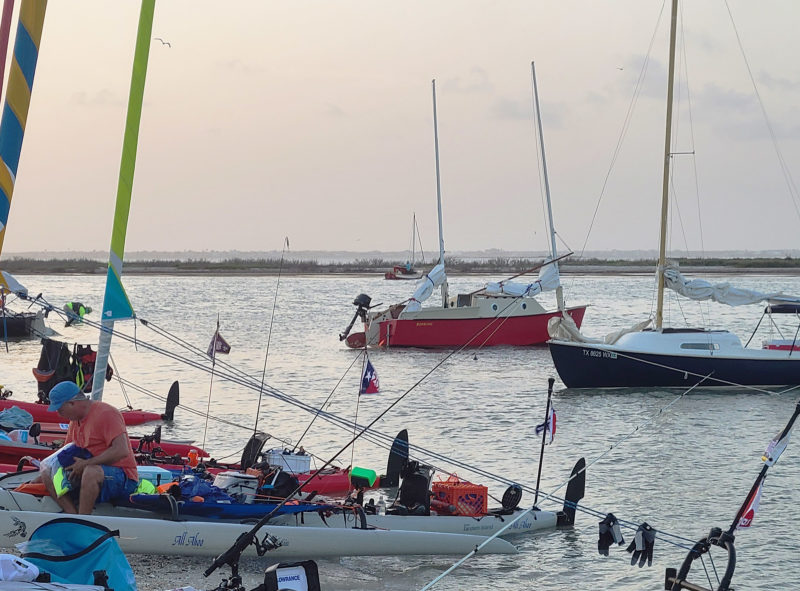
While REDWING was safely anchored and resting peacefully at Quarantine Shore, I didn’t like how the mizzen sail was flopped into the cockpit. My plan is to have a bimini and a topping lift working for next year. There isn’t much point in having a big cockpit if I can’t enjoy it while at anchor.
I followed the chart, keeping track of my compass bearing to Stingray Hole, a 3⁄4-mile gap between the last of three islands that separated me from the channel, and swerved north through the pass and then east on the channel to Port Aransas where six ferries carrying trucks loaded with construction equipment were crossing the channel at surprising speed. I needed to watch them carefully. At the dock, they unloaded quickly and crossed back for the next load. There seemed to be no pattern to their timing, and I fired up the outboard motor so I could stay well out of their way. Barge traffic was also heavy here, and I had to keep my eyes open.
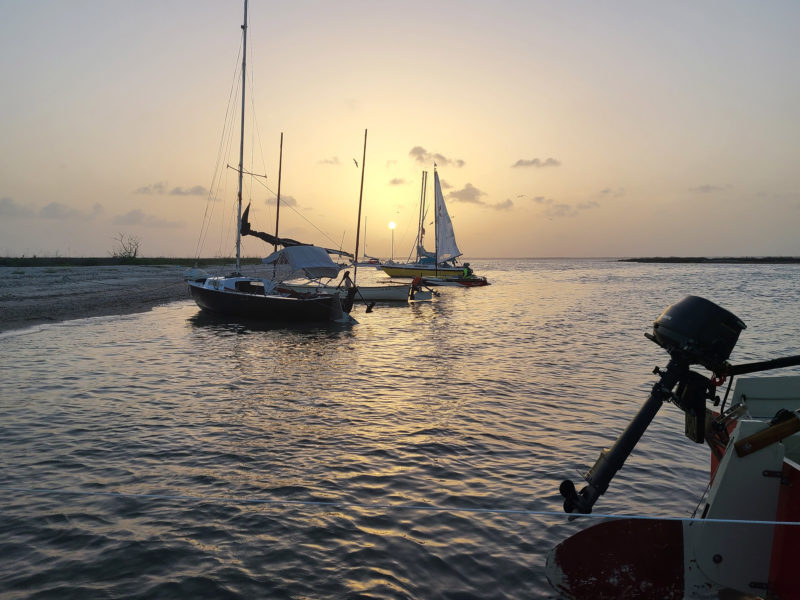
I was watching the sunset from REDWING’s cockpit when Eric Dahlkamp, aboard SQUIRT with her main still up, approached Quarantine Shore. His 13′ trimaran was once a Snark, an 11′ lateen-rigged monohull sailboat made of expanded polystyrene in the ’70s. Eric added foam and fiberglass to raise the hull sides, extend the bow, and add a swallowtail stern. In the transition to trimaran, SQUIRT also got a set of amas and akas.
Beyond Port Aransas my route swung to the north, out of the main channels, to Lydia Ann Channel, which runs along the south end of San Jose Island and opens on Aransas Bay. The fleet was spread out both ahead of and behind me at the approach to Quarantine Shore, and I was enjoying watching everyone sail when REDWING gently slowed to a stop. Laughing that I’d managed to find a ridge of mud just as I’d entered this broad bay, I hopped out, pushed off, and continued.
I sailed northwest to Quarantine Shore and coasted neatly into the shell-beach anchorage under sail. Doug Geis met me and showed me how a pro anchors, with the bow facing away from shore, held off by the main anchor, while the stern anchor was carried onto land and secured. I was appreciative of that—it was part of a great confidence-building day. I spent a pleasant evening with people circled around fires sharing food, drink, and stories.
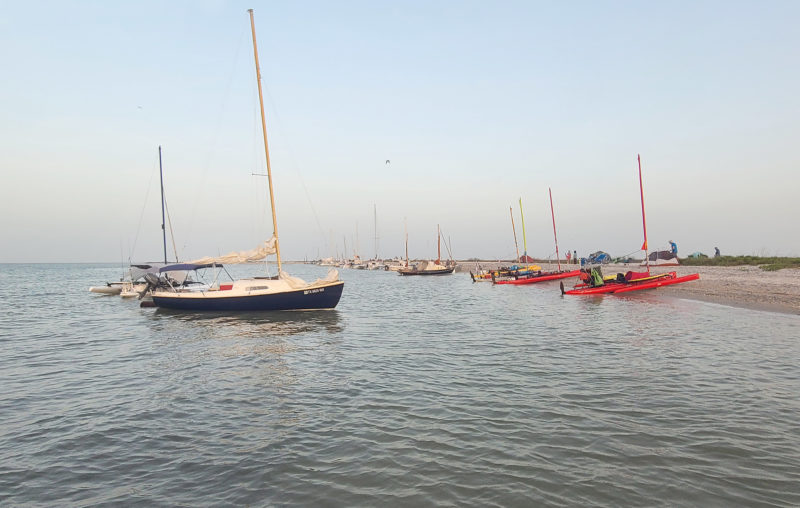
Camp Four on Quarantine Shore was a long stretch of clean beach running northwest–southeast. There was plenty of room for the dozens of boats that spent the night.
I made a leisurely start to the morning, enjoying a mug of coffee when, around 7 a.m., I realized the fleet was busy packing up and heading north. The wind was light, and all of the boats were under full sail. The pinkish morning light spread across the land and water, as puffy blue-gray clouds floated above the sails.
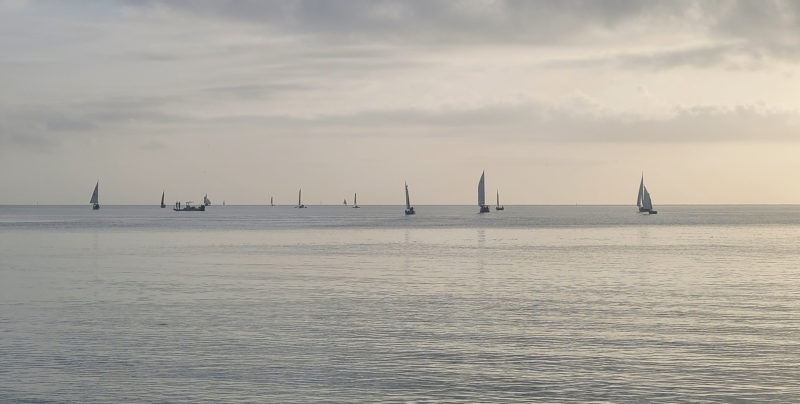
On the morning of Day Five the fleet was up early and heading north in a light wind along Aransas Bay. I was sipping coffee in my cockpit when I took this picture, realizing I needed to get moving since it was going to be a challenge to get to Camp Five at Army Hole, some 50 miles away.
My plan for the day was to sail the ICW to Rattlesnake Island, head to Panther Reef Cut, then go to South Pass, and arrive at Camp Five, Army Hole. The route took the fleet from Quarantine Shore, across Aransas Bay, and through the Deadman Reef Cut, heading northeast into the gentle dogleg of an 8-mile ICW channel between a slender chain of a half-dozen islands. At Bludworth Island, the first in the chain, the trimaran MALABARKA had pulled off to the side, and I could see Fred working on what looked to be his centerboard. In his Sea Pearl, Doug had pulled ashore to help, and I stopped, too. Fred reported that the oyster shells from Quarantine Shore had jammed his centerboard slot, preventing the board from lowering. Within 40 minutes of accepting our help, Fred had his keel moving freely again. We pushed MALABARKA off and he was on his way.
Doug and I agreed we didn’t have enough daylight left to sail nearly 30 miles into the wind to get to Army Hole, and decided to continue along the ICW to Military Cut and find anchorage there.
As the day went on, I caught up with Doug—stuck in the mud. I stopped and helped to push him out.
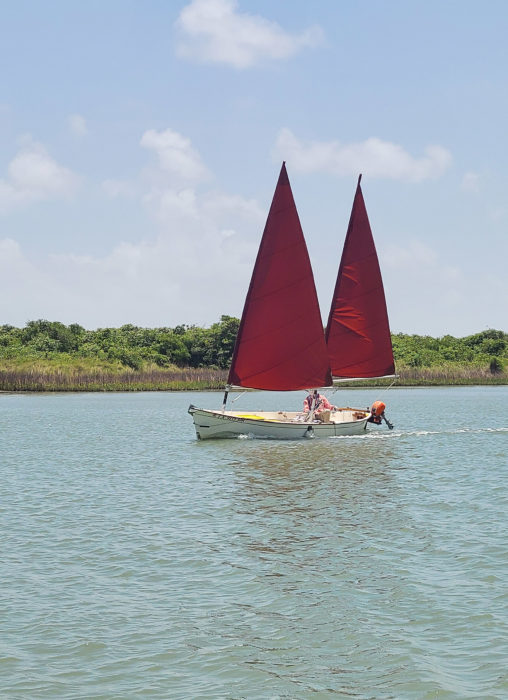
On Day Five, Doug Geis, here at the helm of his Sea Pearl, LA BELLE, sailed with me. I appreciated his frequent mentoring over the course of the Texas 200. His Sea Pearl is well decked out for this type of adventure. Here we had finished crossing the entrance of San Antonio Bay and carried on to where the ICW narrows on its approach to Port O’Connor.
We entered San Antonio Bay. By now the wind had strengthened. We sailed across the bay on a beam reach with the rollers lifting REDWING up and then dropping her bow into a trough with a jolt. I steered her off the wind to ride the rollers longer and slide down them, making for a smoother ride. REDWING rocked back and forth, but it was a fast, exhilarating sail.
I followed a long line of boats across the bay, all of them hanging in there and seemingly doing well.
Since MALABARKA was the fastest boat in our group, Fred was tasked with finding a safe anchorage. He texted back that he had gotten stuck on a shoal until a powerboat happened by and pulled him free. He had made it to Military Cut.
Doug and I suspected that getting to Military Cut wasn’t going to be possible, so we began looking for a camp along the ICW. If a spot had potential, we would slow and take a better look.
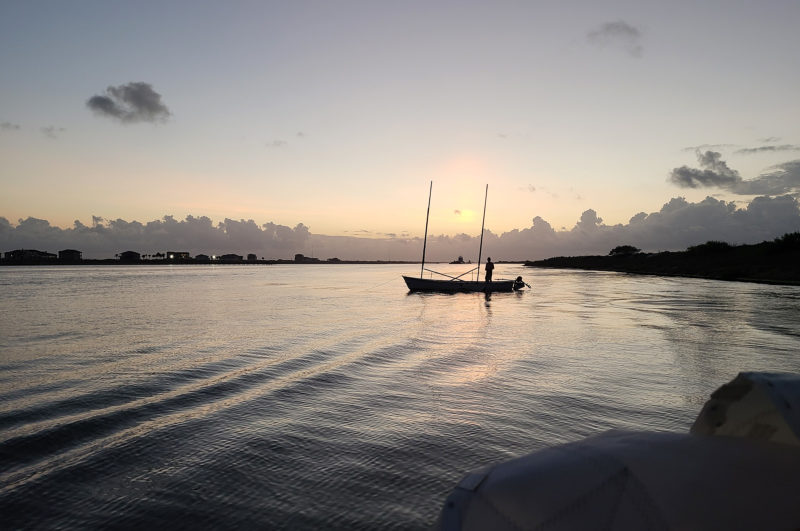
LA BELLE, seen here, and REDWING finally found a safe anchorage on the ICW about 5 miles southeast of Port O’Connor on Day Five. The Sea Pearl’s sails wrap around the masts, which keeps them out of the cockpit. Between the masts, a big barge is visible, heading our way along the ICW.
I thought I had found a place with enough room for the two of us to anchor a safe distance from barge traffic for the night. But as I was checking it out, it seemed like the mud rose up from the bottom and grabbed REDWING. I lowered the sails, got out of the boat, and rocked her up and down, pushing as hard as I could while standing in the knee-deep muck. After 20 minutes she was free.
We were fast running out of daylight. Doug and I dropped our sails, started our motors, and headed farther down the ICW. At dusk we found a spot that would work 3 miles short of Military Cut. A few hours after dark, I noticed another sailboat lit up like a Christmas tree coming down the ICW, sweeping the shore with a flashlight. I suspected they were looking for an anchorage, so I aimed my flashlight on my sails and my boat. The black, non-motorized, fiberglass sloop slid ashore next to REDWING. The exhausted crew, a father and two teenage sons, thanked me and quickly retired for the night.
T he first thing I did in the morning was clean the boat. REDWING was filthy from the mud I’d brought onboard from freeing her the day before, and as always, there was water on the cabin floor. LA BELLE and the sloop—I never saw its name—both left, and 15 minutes later I, too, was on my way.
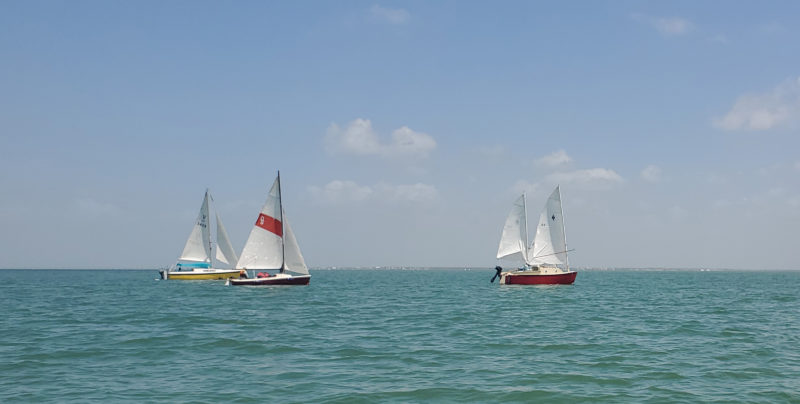
On Day Six, REDWING, along with two other boats, had turned the corner at Port O’Connor and headed northwest to a Texas barbecue at the Magnolia Beach finish.
The day’s route would take me northeast down the ICW to Port O’Connor, where I would turn to the northwest along the Matagorda Bay shore for Magnolia Beach, where my truck and trailer were parked. I pushed off, entered the ICW under full sail, and had traveled a mile when the wind changed to the northeast, heading me off my course. I really wanted to sail as much as I could, but didn’t relish tacking back and forth across the channel and dodging barges, so I dropped the sails and started the outboard.
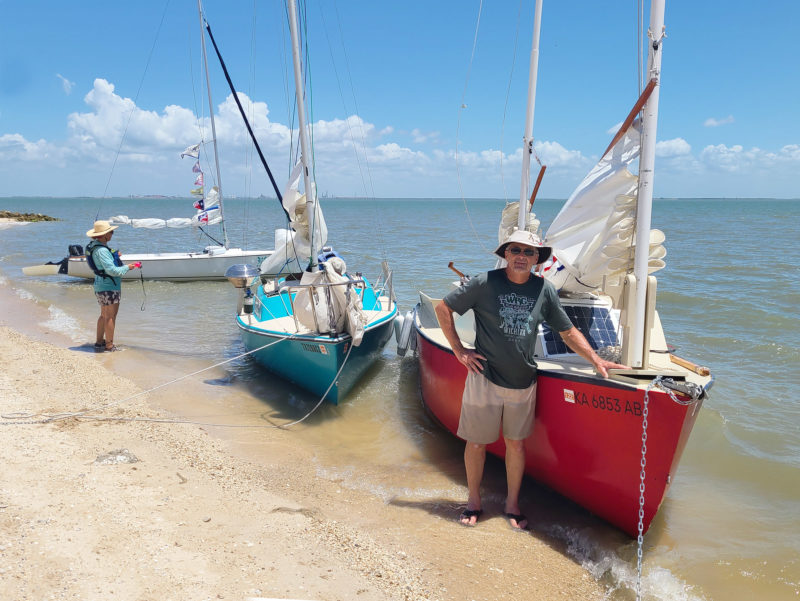
I finished the Texas 200 next to John and Jennifer Harnett on their boat, WATER ON THE MOON. Both of our boats are named after songs. My original intention was not to singlehand the event, but my crew had a family situation arise a few days before we were due to leave so I decided to go it alone. I am glad I did. My sailing skills improved immensely, I felt good assisting others, and boosted my confidence in my own ability to handle adversity.
David Zumwalt is a retired school administrator who lives in Wichita, Kansas. He sails a Catalina 25 on Cheney Reservoir and is a member of the Ninnescah Sailing Association. The first sailboat he built was a Puddleduck. After attending the 2011 Puddleduck championships and meeting several boat designers he decided to build a Belhaven 19, which he completed eight years later.
If you have an interesting story to tell about your adventures with a small boat, please email us a brief outline and a few photos.
Share this article
Join The Conversation
We welcome your comments about this article. If you’d like to include a photo or a video with your comment, please email the file or link.
Comments (4)
Thanks, Doug, for sharing the unvarnished detail of your 200-mile learning experience!
Minor correction to an otherwise good story: the owner/builder of the trimaran SQUIRT is Eric Dahlkamp. Enjoyed the story. Your descriptions of mud experiences are vivid and right on point!
Thanks for catching that, Steve. I’ve corrected the error in the caption.
A courageous effort! I hope that you were able to repair all the problems you found, once you got home. Oh, and you’ve confirmed me (again) as a daysailor.

Leave a Reply Cancel reply
Your email address will not be published. Required fields are marked *
Stay On Course
More From This Issue
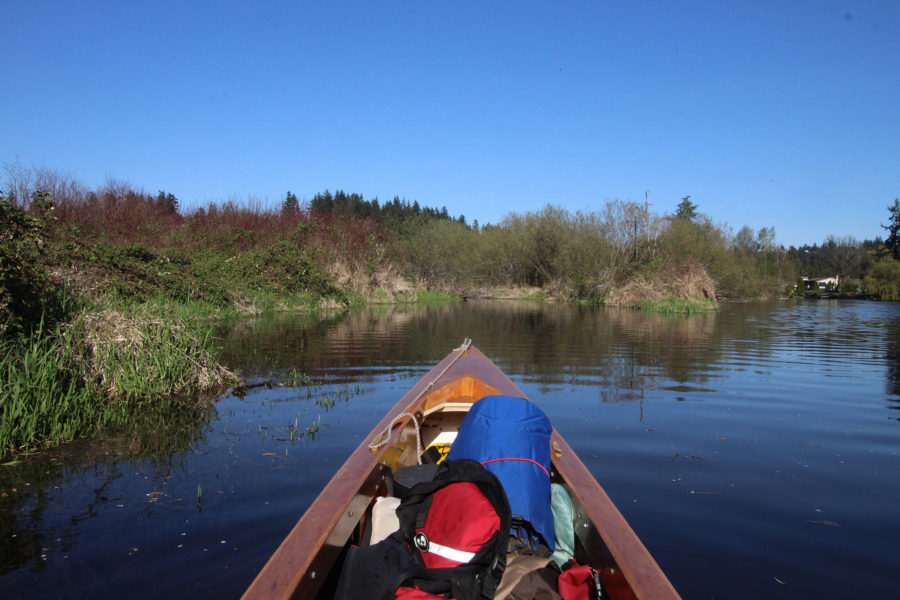
From The Editor
Purposeless
A few days ago, I needed to take a long-overdue break from all the things I had yet to do, not only for work, but also around the house. I…
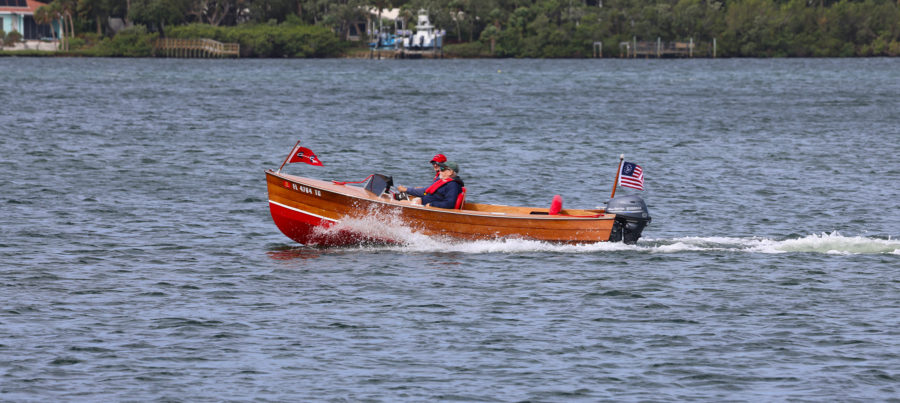
Boat Profile
Rhode Runner
I wanted to build an outboard boat that would be fun to use in Florida, something eye-catching and different. I had always been drawn to classic runabouts, particularly the Chris-Crafts…
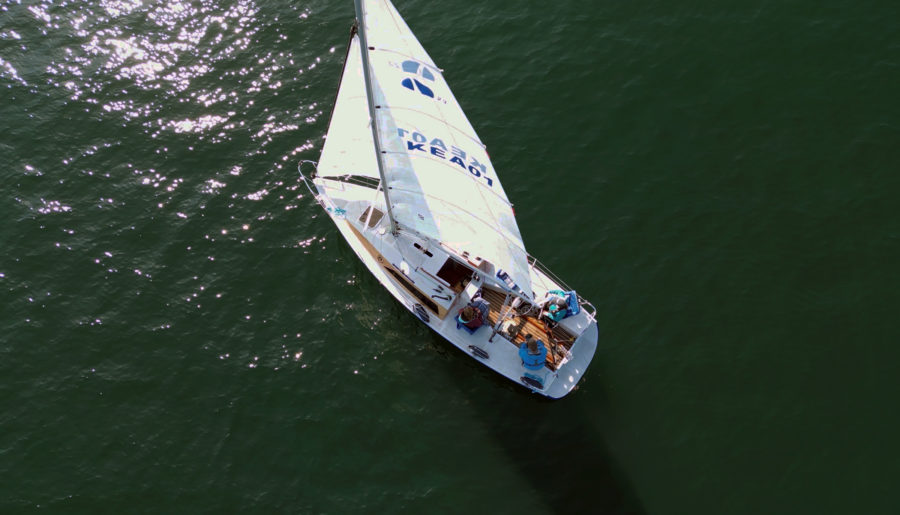
For many years I had searched for a boat that could sleep four, had decent headroom, a separate head compartment, great sailing performance, and a drop keel so that I…
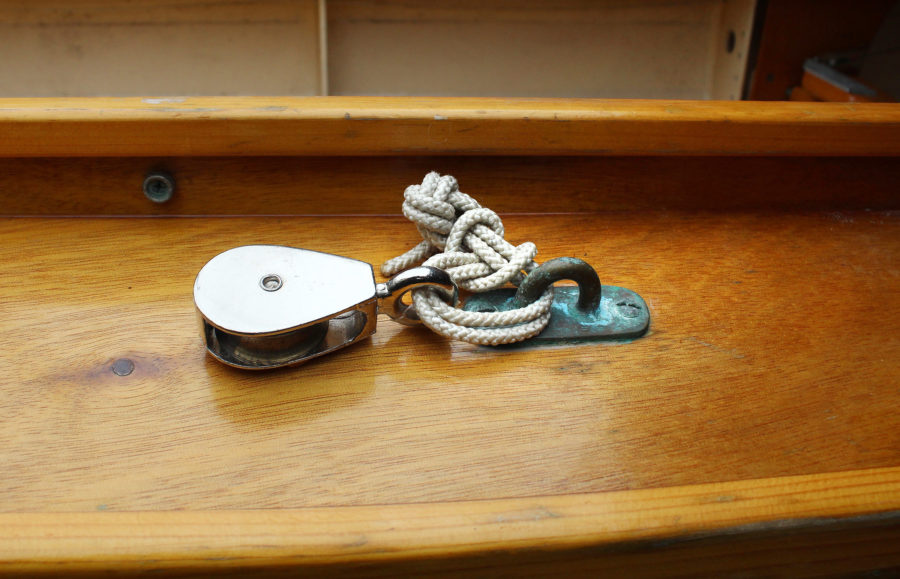
DIY Soft Shackles
I’ve made soft shackles in laid line, solid braid, and kernmantle cord in both 1/8″ and 3/8″ and they have all worked well using the same method. The stopper knot…
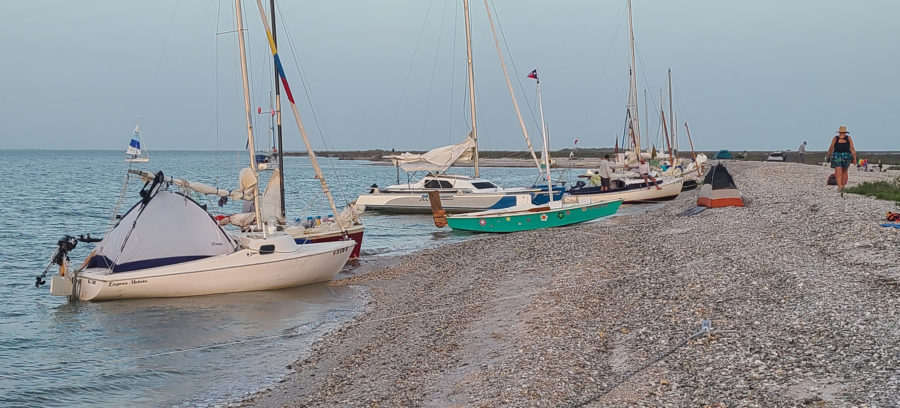
I didn’t have much experience in heavy-weather sailing, but REDWING was designed to sail safely in strong winds. Both sails have two reefs, and the masts are unstayed and bend…
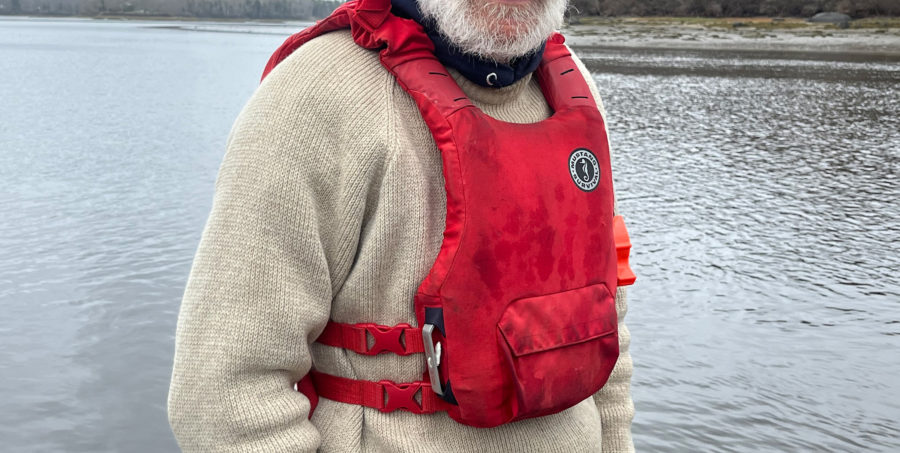
Product Reviews
The Khimera’s foam provides 7.5 lbs of buoyancy and its air bladders add 13 lbs when inflated, for a total of 20.5 lbs. (The minimum buoyancy for a foam Type…
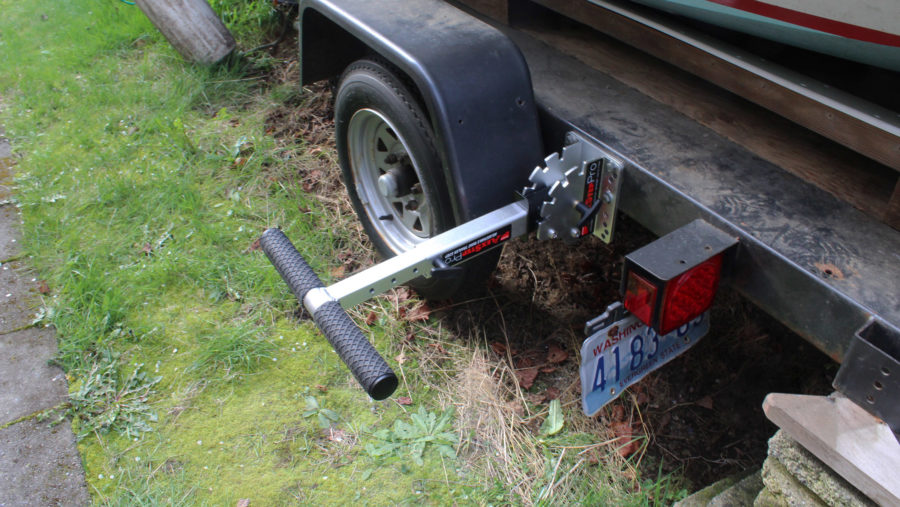
FlexStep Pro
For the best part of my life, I’ve enjoyed every aspect of small boats, with one exception: climbing in and out of them while they’re on their trailers, whether at…
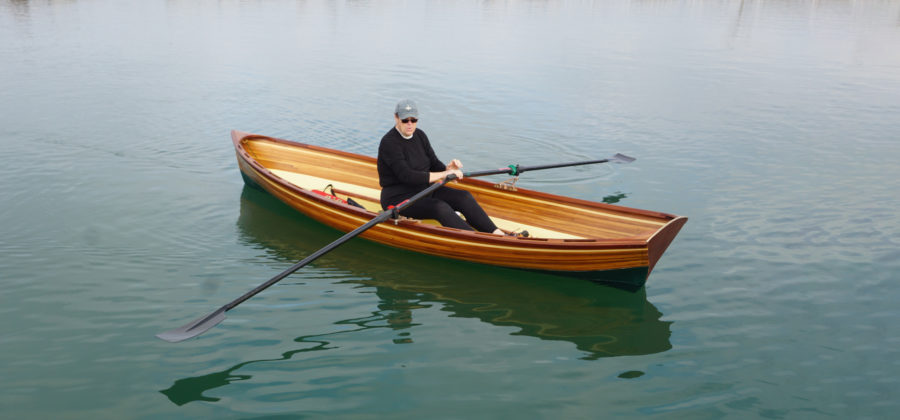
Reader Built Boats
He had always wanted to build and row a Whitehall, attracted to the boat’s history as well as its proven performance and classic lines. But there were two problems. First,…
More Adventures
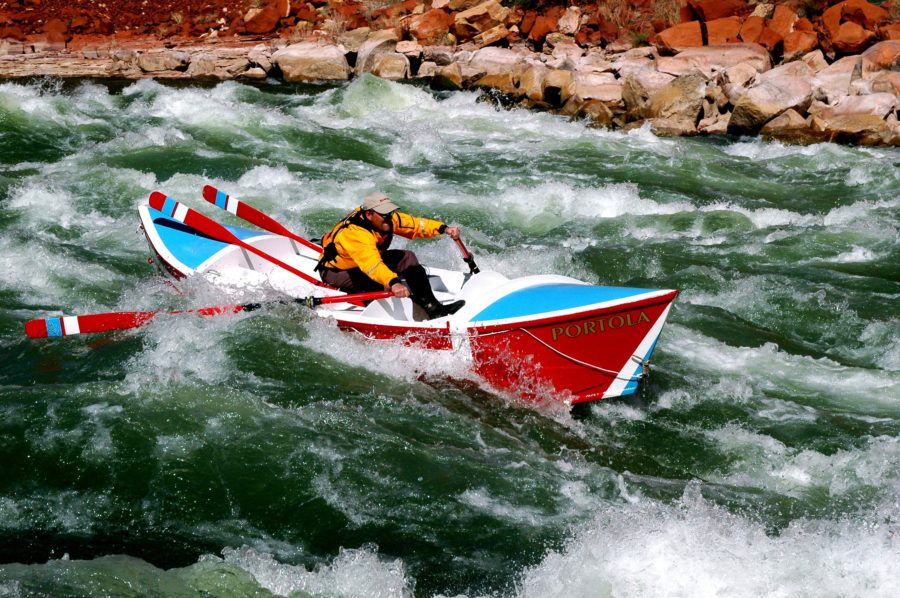
Dories in the Canyon
In the early 1960s Martin Litton, a travel editor for Sunset magazine, came to the McKenzie River in Oregon to write a story. When he got there, he saw wooden…
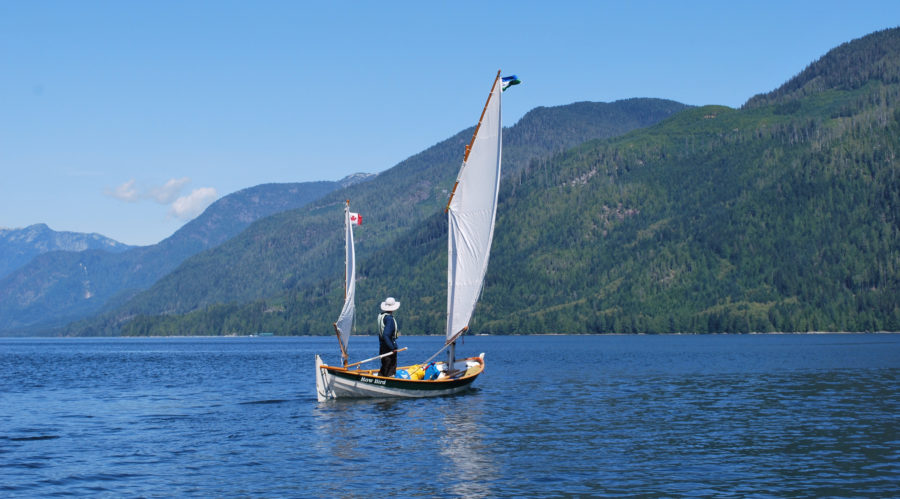
Southing in the Inside Passage
When the fog lifted, I rowed east along the upper reaches of Johnstone Strait into the Broughton archipelago through the churning currents in Blackney and Whitebeach passages. In the fluky…
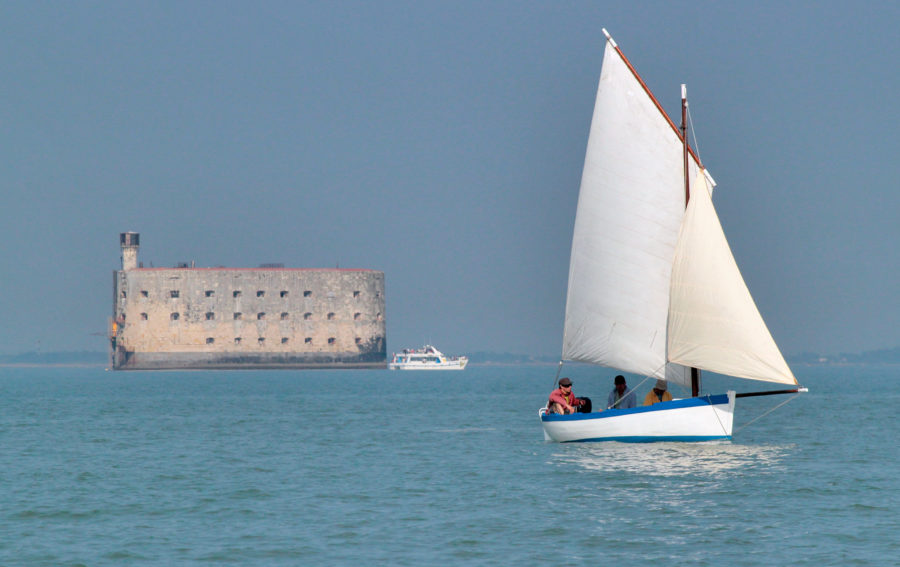
The Sailing Light Challenge
The French love sailing, but the big and expensive racing and cruising yachts often get all of the attention. Two years ago I got together with a group of friends…

Two Tramps and a Lady
After spending a night at a canal-side campground in Villeneuve-les-Béziers, it was already 80°F by 9 a.m. the next morning. Ben and I each set a now faded, flattened, and…
Subscribe Today!
Become a subscriber today and you’ll recieve a new issue every month plus unlimited access to our full archive of backlogged issues.
Already a subscriber? Sign In
Subscribe For Full Access
Flipbooks are available to paid subscribers only. Subscribe now or log in for access.

IMAGES
VIDEO
COMMENTS
She is named, Belhaven, after the historic town, located on the Pungo River – a well known place for the wind and waves to kick up and kick in. The gentle keel shape, with shallow draft and light weight, will make the boat easy to tow without having to purchase a large SUV.
Belhaven 19 First Sail. Bob Carson's first launch of his recently purchased Belhaven 19 sailboat. Crewed, photographed and videoed by Mike Singleton on Lake Lewisville, Texas on May 13,...
Bob Carson’s Belhaven 19 after this years 2024 Texas 200
I'm new to the forum and just this week heard about the Belhaven 19 (Thanks Tom Lathrop). I'm casting about for a small sailboat to build. I'm a fan of Sam Devlin, John Wellsford & Jay Benford, among others. I've never seen a cat ketch boat up close and certainly never sailed one.
Alan from B&B sent me some coresound rigging drawings but I would love to see any pictures anyone might have for the main sail on their Belhaven, especially for main sheet control and reefing from the cockpit. I plan to do the T X 200 this year and wish to get the rigging set as needed.
REDWING, my home-built Belhaven 19, was one of 80 or so boats that entered the 2022 Texas 200, a raid covering a 200-mile-long stretch of the Texas coast. The course meanders north roughly following the Intracoastal Waterway (ICW) over a five-day period beginning June 14th.